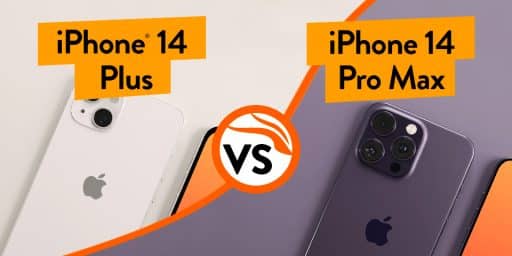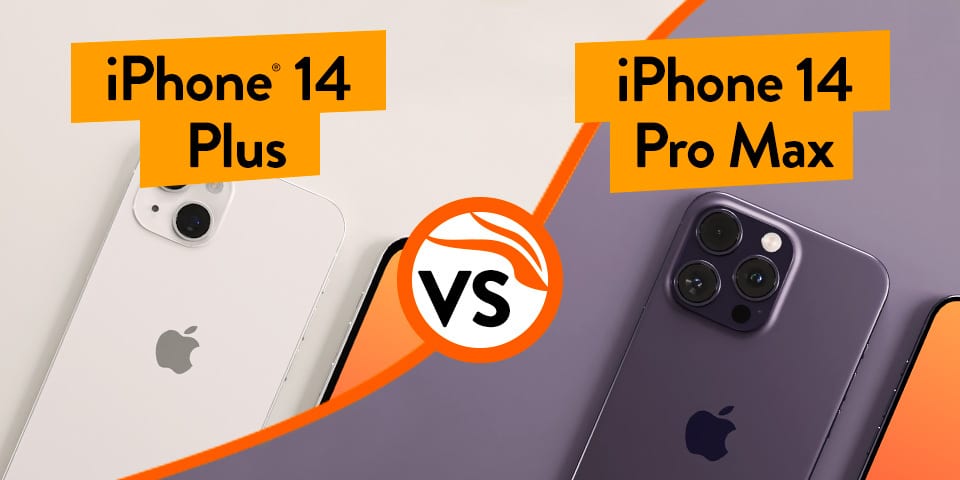If you’re trying to decide between an iPhone 14 Plus and an iPhone 14 Pro Max, let this guide help you compare the features and functionality of these late-model iPhones. Apple gave shoppers a choice of these two big-screen models when the phones were released in 2022. Either of them is a great purchase, but although they share a range of similarities, some features are different.
The OLED display brings relatively new engineering to the iPhone 14, and there’s a lot more to love about both of these higher-end models, each of which comes with a bigger 6.7 inch screen.
Compare the iPhone 14 Plus and iPhone 14 Pro Max for high-performance iPhones that set the bar when it comes to sophisticated smartphone design. Get either of these excellent devices from a company that believes in top-of-the-line customer service, and in saving harmful heavy metals from landfills, in order to help the environment. You can read more about this mission on our web site and find out how you can buy, sell or trade devices responsibly.
In buying from Gazelle, you’ll also get our guarantee of quality, with a 30-point inspection process for all pre-owned iPhones and other devices. Our inventory offers transparent pricing and condition information, along with a range of iPhone 14 Plus and an iPhone 14 Pro Max choices, with different storage options, styles and colors, just like you would choose from when ordering from the factory. But you’ll save a lot of money by choosing to buy a pre-owned device while still getting a lot of the new technology you hunger for!
So let’s look at what’s different between these two iPhone models…
iPhone 14 Plus and iPhone 14 Pro Max – Camera Systems
One of the biggest differences between the iPhone 14 Plus and the iPhone 14 Pro Max is that the iPhone Pro Max has a 48 megapixel main camera in addition to 12 megapixel ultra wide and telephoto lenses, where all of the cameras on the iPhone plus are 12 megapixels. So the Pro Max wins handily in terms of rear cameras, while it has a lot of other exciting cutting-edge technology, too.
On the other hand, the 14 Plus is lighter weight than the Pro Max model. The Plus’s camera lens is smaller, but it’s missing the larger telephoto lens on the Pro Max. So those who want a lighter phone might choose to buy the 14 Plus.
Another important thing to know about these phones and camera system choices is that both the iPhone 14 Plus and the iPhone 14 Pro Max include a relatively new feature called cinematic mode.
So what does this do?
Cinematic mode basically adds some capabilities for video design, such as a better ability to focus on a subject, and then move to another subject, while shooting video. To achieve this, cinematic mode uses something called ‘rack focus,’ along with the built-in Dolby vision HDR engineered by Apple on this model range.
Another capability of cinematic mode involves better depth of field.
The switching of focal subjects with cinematic mode represents part of a broader move by Apple to make its camera design smarter and more agile. Think about in terms of the context of image processing, and how computer vision is revolutionizing what device cameras take in, how they process it, and what the final product looks like. That’s going to inform any design, whether its a big-screen choice like the iPhone 14 Plus or iPhone 14 Pro Max, or, say, an iPhone mini.
iPhone 14 Plus and iPhone 14 Pro Max: Display
In looking at differences between the iPhone 14 Plus and iPhone 14 Pro Max, the 14 Pro Max has a smaller notch, and the phone uses the Apple Dynamic Island system for alerts, notifications and feeds.
The iPhone 14 Pro is the first type of phone to have Apple’s Dynamic Island feature, which consists of a pill shaped item at the top of the screen that’s sort of a command center for Apple notifications and more. Dynamic Island was pioneered for the iPhone 14 Pro, but it was then put into all of the iPhone 15 models.
There are many kinds of alerts and notifications that show up on Apple’s Dynamic Island. Users see notices of airdropped file transfers, AirPlay connections, focus mode changes and shortcut actions. They get some kinds of Sim card alerts, and notifications when connecting accessories. They’ll see when the flashlight is on, or use Dynamic Island for vehicle syncing features. They also get notifications about battery life, and charging status, and silent mode.
In terms of background activities, Apple’s Dynamic Island will announce phone calls and their duration, as well as annotating some types of music playing and displaying timers. There are also certain kinds of long-press controls built into Dynamic Island for convenient shortcuts.
In other display news, all iPhone 14 models have the OLED display that replaces the old LCD system. OLED provides its own backlighting for vibrant color contrast and versatility.
In terms of display, the Pro Max also has an edge in that it has the always on display feature. The always on features part of what smartphone owners love about the this model. For those who don’t want to have to always unlock their phone just to see basic screen display information, always on helps them get around this requirement and saves time and effort in all kinds of daily tasks involving your smartphone.
So if you’re the type of person who is frustrated by the endless inputting of your pin number to unlock your device, you may want to consider a phone that has the always on feature. An alternative, though, is to use lock screen widgets, which can be done with any iPhone 14 to allow important details to show up on the screen, even when the phone is locked.
iPhone 14 Plus and iPhone 14 Pro Max: Chip and Performance
While the iPhone 14 Plus has Apple’s A15 bionic chip, only the Pro Max has the next generation of Apple’s system-on-a-chip the A16. Although performance is going to vary, the A16 has the same number of cores as the A15,. but a higher clock speed. It also has 16 billion transistors compared to the A15’s 15 billion.
Specifically, the A16 gets better marks for many reviewers in terms of gaming performance, battery life, memory bandwidth and instruction set architecture. It also has a smaller transistor than the A15 – as part of the evolving design included placing larger numbers of smaller transistors on a chip. The A16 also benefits from a modern multicore design.
Experts also note the A16’s better instruction set architecture, and it gets higher scores from android tool AnTuTu, which measures performance on android devices.
iPhone 14 Plus and iPhone 14 Pro Max: The Promise of Lidar
Another new technology that’s in the iPhone Pro Max is a lidar scanner. This tool can measure the distance between the phone and various objects to create visual maps. It’s helpful for better photo taking and for some types of augmented reality programs. It was unveiled on certain iPhone 12 and iPhone 13 Pro models, and it’s included in the Pro Max design for the 14 as well, but not the Plus.
iPhone 14 Plus and iPhone 14 Pro Max: Battery Life
Where the iPhone 14 Plus is estimated to have about 26 hours of battery life for video playback, the Pro Max model is estimated to have about three hours more. That gives you an idea of the relative battery performance between the two phone models, although the actual use time depends on factors like age of the battery and specific use.
iPhone 14 Plus and iPhone 14 Pro Max: More Image and Video Capabilities
Action video mode is available on both phones, but only the iPhone 14 Pro Max gives you the ability to shoot proRAW images at 48 MP, and the telephoto means the model also offers more zoom. Essentially the proRAW mode adds useful information to images, along with what’s called multiframe processing. However, it’s important to think about how this will decrease the phone’s storage capacity, because image files are generally bigger.
One other item that’s on the iPhone 14 Pro Max and not the Plus is adaptive true tone flash. The iPhone plus has the true tone flash, but the Pro is the only one that has the adaptive feature for this camera use. The adaptive true tone flash has nine LED components that can switch patterns depending on camera strategy. The pattern and intensity of the lights match the size of the photo. The Pro Max also has night mood, and macros for photography, adding to the toolkit for enthusiastic photographers.
iPhone 14 Plus and iPhone 14 Pro Max: Color and Style
Buyers can also choose from a range of colors for each of these iPhones: the Plus is available in blue, purple, midnight, starlight, and red – the Pro Max is available in deep purple, space black, silver and gold. You can also choose to buy either of these models with a range of storage capacity: see our product specifications on the site for more details.
Comparing the iPhone 14 Plus and iPhone 14 Pro Max
To recap, the iPhone 14 Plus and iPhone 14 Pro Max have roughly the same display technology, and a lot of the same camera functions, notwithstanding the telephoto lens difference, but the Apple iPhone 14 Pro Max has some bold new features, including the dynamic island, and the lidar capability.
Then there’s also the faster microprocessor design on the Pro Max.
At the end of the day, many would consider the iPhone 14 Pro Max to be a top-of-the-line iPhone 14 model. However, both of these phones have advanced features, and represent the great engineering that came out of this model year from Apple.
You can get either of these great smartphones in different storage options and colors from Gazelle. We’re always looking at how to get you the best deal on a pre-owned refurbished device like an iPhone or tablet – a better deal, frankly, than most people can get on a new iPhone or other Apple devices. You can save hundreds of dollars deciding to go with a pre-owned phone model that can give you just as much functionality, without the enormous cost. When you start purchasing used devices from Gazelle, you may never want to go back to the big box store to get new ones, even on financing.
Frequently Asked Questions
Is the Pro Max much better than the iPhone Plus?
The Apple iPhone Pro Max has better battery life, a faster microchip, and some better displaying camera features. It’s generally a higher-end phone than the Plus, but comes with a higher price, too. Both phones have a range of more common Apple features that show off the engineering that the manufacturer brought to this model year. To choose between the Plus and the Pro Max, think about whether you need the advanced features, for specific high-impact uses or particular kinds of projects.
Is the Apple iPhone 14 Plus waterproof?
The Apple iPhone 14 Plus has an IP68 rating that shows its water resistance for up to half an hour at a depth of 6 meters. The Pro Max comes with the same guarantee. The IP68 rating represents an advance in water resistant design, where older phones have none of the same guarantees.
Are the iPhone 14 Plus and iPhone 14 Pro Max the same size?
A regular iPhone 14 hs a screen display size of 6.1 inches – the iPhone 14 Plus and iPhone 14 Pro Max are both 6.7 inches. They’re both bigger-screen Apple phones. So consider that if you buy one of these devices, the readability may be better, but they will not fit as nicely into a pocket.
Which iPhone is more expensive, the iPhone 14 Plus or iPhone 14 Pro Max?
All things being equal, the iPhone 14 Pro Max comes with a higher price tag. It’s also heavier than the iPhone 14 Plus. It has several elements of new technology that are absent from the iPhone 14 Plus.
Is an iPhone 14 Plus worth buying?
Any iPhone 14 model is a good choice, with lots of Apple’s prominent engineering on these later model phones. Where older versions like the iPhone 12 and 13 are marked for end of support nearer the middle of the decade, the iPhone 14 should have longer-term support from the manufacturer, until 2029. In making the decision on an Apple iPhone, it’s best to understand how these models are evolving each year with different choices like Plus, Pro and Pro Max.
Can I take my iPhone 14 Plus or Pro Max in the shower?
Even though these phones are rated for water resistance at a depth of 6 meters for up to half an hour, it is not advisable to expose these phones to water. That includes showering with them, or carrying them in the rain. There is always a chance of some type of damage related to water getting into various nooks and crannies on your smartphone device.


